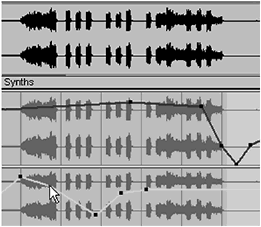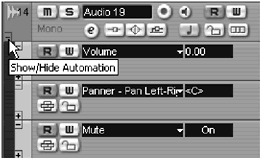Automation Subtracks
| [ LiB ] |
Automation Subtracks
Automating inside Cubase is not limited to the Mixer window. You can also add automation to the automation tracks available in each track in the project window (see Figure 13.1). Automation parameters can be displayed in several ways:
Figure 13.1. Automation subtracks.

How To
To view automation subtracks:
-
Click the plus sign in the lower-left corner of the desired track in the Track List area of the project window (see Figure 13.2).
Figure 13.2. The show/hide automation subtracks button.

-
Or, right-(PC)/Ctrl-(Mac) click over the track in the Track List area and select the Show Automation, Show Used Automation, or Show Used Automation for All Tracks options from the context menu.
Automation recorded in these subtracks is no different than the automation recorded in the Mixer window. Automation is always displayed under the track it is associated with; an automation line is displayed over a background representation of the content currently playing in the track. The only difference is the way you record these events. When automation is recorded or edited in one location, it is updated in the other location as well.
Cubase offers two automation methods : by recording the automation using the Read/Write buttons on mixer channels, or by actually drawing automation points on the automation subtracks. Both methods offer similar results, and actions you do using one method will update the results in the other. For example, you can record automation in the Mixer and then later decide to edit this automation using the Pencil tool inside the project window.
All track classes have their own sets of subtracks, depending on what can be automated on them. For example, VSTi tracks can hold as many subtracks as there are parameters and channels available for that particular VSTi. Similarly, a Rewire folder track will appear as soon as you enable a Rewire channel in your project. If you record automation for this channel, the automation is stored in additional subtracks, corresponding to the parameter you edited. Even MIDI tracks have automation subtracks for mixer- related settings, inserts , or send parameter automation. Normally, MIDI will use Control Change messages along with System Exclusive messages to automate MIDI devices, but since some of the parameters you can automate inside Cubase are not supported by MIDI, MIDI automation subtracks pick up where MIDI left off. The more parameters you automate in a single channel, the more automation subtracks you will create for this track.
When automating FX channels, each parameter you move during the automation process will generate a subtrack associated with this channel. So you can, for example, progressively make a room bigger by changing (over time) the room size, reverb time, and predelay parameters on a reverb just as easily as you can create a fade out or pan movement on an audio track.
| [ LiB ] |